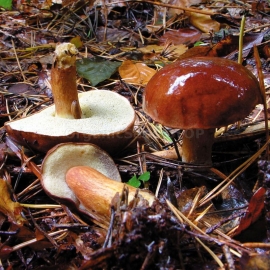 EXCLUSIVE
EXCLUSIVE





Bay Bolete / Imleria Badia - Organic Mushroom's Dry Mycelium
6.10 €
Imleria badia, commonly known as the bay bolete, is an edible, pored mushroom found in Europe and North America, where it grows in coniferous or mixed woods on the ground or on decaying tree stumps, sometimes in prolific numbers.
-
Organic Bay Bolete Mushroom's Dry Mycelium
Imleria badia, commonly known as the bay bolete, is an edible, pored mushroom found in Europe and North America, where it grows in coniferous or mixed woods on the ground or on decaying tree stumps, sometimes in prolific numbers.
Both the common and scientific names refer to the bay- or chestnut-coloured cap, which is almost spherical in young specimens before broadening and flattening out to a diameter up to 15 cm (6 in). On the cap underside are small yellowish pores that bruise dull blue-grey when injured. The smooth, cylindrical stipe, measuring 4–9 cm (1.6–3.5 in) long by 1–2 cm (0.4–0.8 in) thick, is coloured like the cap, but paler. Some varieties have been described from eastern North America, differing from the main type in both macroscopic and microscopic morphology.
First described scientifically by Elias Fries in 1818, the bay bolete was reclassified as Xerocomus badius in 1931, and it is still listed thus in several sources. Modern molecular phylogenetic studies show Xerocomus to be polyphyletic (not descended from a common ancestor), and the bay bolete is not particularly closely related to species in that genus.
Often considered a poor relation of the cep (Boletus edulis), I. badia is nevertheless regarded as a choice edible mushroom by some authors, such as food expert Antonio Carluccio, and is sold in markets in Europe and central Mexico. Its mushrooms are less often infested by maggots than other boletes.
Often considered a poor relation of the cep (Boletus edulis), the bay bolete is nevertheless highly regarded as a choice edible mushroom by some authors such as Carluccio. In central Mexico, it is collected from Izta-Popo Zoquiapan National Park and sold in neighbouring markets. It may cause an allergic reaction in some people, and the blue discolouration upon bruising can be offputting, although the staining disappears from white flesh when it is cooked.
The flavour is milder than its better-known relative. Younger specimens are best for eating, though more mature ones can be suitable for cutting up and drying. The tendency for the pores to absorb water means that wiping rather than washing is recommended before use in the kitchen. Unlike most boletes, I. badia can be eaten raw (though only young mushrooms should be used). Otherwise it can be fried in butter, or used with meat or fish recipes. Mushrooms can also be frozen, dried, or pickled in cider vinegar, wine, or extra virgin olive oil, and later used in sauces or soups.
The fruit bodies can be used to make mushroom dyes. Depending on the mordant used, colours ranging from yellow, orange, gold, and green-brown can be obtained. Without mordant, a yellow colour is produced.
